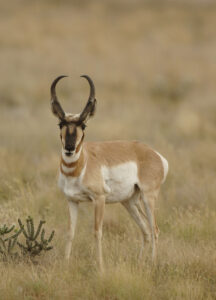
Arizona pronghorn buck, photo courtesy of George Andrejko, Photographer, Arizona Game and Fish Department
Did you know that the fastest land mammal in North America lives in our area? Pronghorns achieve speeds approaching 60 mph and they can maintain 40 mph for almost 2 miles. The only mammal faster in the world is the cheetah.
Historically, there were hundreds of thousands of pronghorn in Arizona. They were so abundant that early explorers and settlers ate almost as much pronghorn as deer. Its hide was valued as much as leather. By 1920, the pronghorn population was down to 650 in 18 locations across Arizona and they were close to local extinction. By 2000, conservation and management actions resulted in the population of pronghorn in Arizona increasing to approximately 10,000. However, pronghorn are in only 25% of the area they used to be in the United States and Canada prior to Euro-American settlement, so more work is needed.
Populations of pronghorn in Arizona are no longer widespread, but rather fragmented into isolated populations and in much smaller areas. Highways, roads, subdivisions, arroyos, and fences have all contributed to this fragmentation
The greatest change in Arizona pronghorn population has been caused by humans. The large number of livestock brought in after 1882 transformed Arizona’s natural environment. Previously, there had not been large plant eating animals. Introducing domestic stock resulted in removing much of the grass cover. This reduction in grass cover profoundly influenced the occurrence and distribution of wildlife. Floods and drought, and the lack of fire further impacted wildlife populations, including pronghorn.
Fire suppression was used for approximately a hundred years, which allowed small trees to take over grasslands. This reduced the amount of vegetation that pronghorn eat. Fire management efforts of the last 30 or so years has helped the natural vegetation to grow and has reduced junipers, mesquite, cat claw and acacia. The result has been a decline in grasslands, which is the habitat in which pronghorn evolved and still need today. Pronghorn have become more vulnerable to predators because the vegetation reduces a pronghorn’s ability to see predators. The Red Rock Ranger District of the Coconino National Forest is working on a forest-wide grassland restoration analysis so grassland conditions can be improved and more information will be available in the future.
The introduction of livestock also resulted in hundreds of miles of fencing being built to manage the herds. Traditional livestock fences have low barbed wire. Unfortunately, pronghorn prefer crawling under a fence than jumping over it. This not only fragments their habitat and makes crossing the land difficult, but also results in pronghorns being caught on the low barbed wire and dying.
One of the Forest Service’s responsibilities is to ensure that a species’ habitat is protected from all the various land use activities (such as grazing, recreation, utilities, roads, fire, etc.). The Coconino National Forest, in partnership with volunteers from Friends of the Forest, is working to remove unnecessary fencing and replacing fencing that was not built to accommodate pronghorn. Fence modification includes removing the bottom barbed wire and replacing it with smooth wire that is 18-20 inches above the ground.
“The pronghorn population in the grasslands north of Cottonwood and west of Highway 89A has grown from 25-30 up to 50 in the Coconino National Forest since the early 1990’s. We have been working for years to remove encroaching trees in our grasslands and have been modifying fences to be more amenable to pronghorn passage.” said Janie Agyagos, Wildlife Biologist, Coconino National Forest, Red Rock Ranger District. “Since a viable population should consist of 100 animals, the Forest Service is working on a proposal to reopen a historic crossing between the Coconino and Prescott National Forest. This would allow the Cottonwood herd to, once again, be able to interact with another herd, improve genetics and population health.”
Want more information about volunteer opportunities like modifying existing fencing to be pronghorn-friendly with the Friends of the Forest? Visit www.friendsoftheforestsedona.
Serving Sedona, written this week by Carol Dores, Friends of the Forest, appears Wednesday in the Sedona Red Rock News.